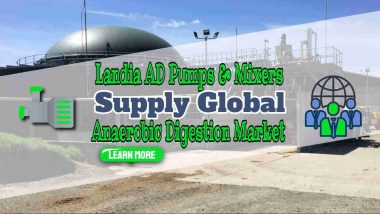The Biogas Info website was created in 2009 as an independent authoritative resource on all things AD. The creation of the site was supported byte UK Government and industry. The site was developed and is maintained by NNFCC.
Anaerobic digestion (AD) is the breakdown of organic material by micro-organisms in the absence of oxygen. AD produces biogas, a methane-rich gas that can be used as a fuel, and digestate, a source of nutrients that can be used as a fertiliser. Increasingly AD is being used to make the most of our waste by turning it into renewable energy.
Biogas a Definition
Biogas is a mixture of gases, primarily consisting of methane, carbon dioxide and hydrogen sulphide, produced from raw materials such as agricultural waste, manure, municipal waste, plant material, sewage, green waste and food waste.
Biogas is primarily methane (CH4) and carbon dioxide (CO2) and may have small amounts of hydrogen sulfide (H2S), moisture and siloxanes. The gases methane, hydrogen, and carbon monoxide (CO) can be combusted or oxidized with oxygen. This energy release allows biogas to be used as a fuel; it can be used in fuel cells and for any heating purpose, such as cooking.
Description, Production, Uses, and Facts
Biogas is a mixture of around 60% methane, 40% carbon dioxide and traces of other contaminant gases.
Biogas can be compressed after the removal of carbon dioxide and hydrogen sulphide, the same way natural gas is compressed to CNG and used to power motor vehicles. In the United Kingdom, for example, biogas is estimated to have the potential to replace around 17% of vehicle fuel.

Government Financial Support
It qualifies for renewable energy subsidies in some parts of the world. Biogas can be cleaned and upgraded to natural gas standards when it becomes bio-methane. Biogas is considered to be a renewable resource because its production-and-use cycle is continuous, and it generates no net carbon dioxide.
As the organic material grows, it is converted and used. It then regrows in a continually repeating cycle. From a carbon perspective, as much carbon dioxide is absorbed from the atmosphere in the growth of the primary bio-resource as is released, when the material is ultimately converted to energy.
What Is a Biogas Plant and How Does It Work?
Biogas is produced in a biogas plant by microorganisms, such as methanogens and sulfate-reducing bacteria, performing anaerobic respiration. Biogas can refer to gas produced naturally and industrially.
In soil, methane is produced in anaerobic environments by methanogens but is mostly consumed in aerobic zones by methanotrophs. Methane emissions result when the balance favours methanogens. Wetland soils are the main natural source of methane.
The purpose of industrial biogas production is the collection of biomethane, usually for fuel.
Biogas differs from natural gas in that it is a renewable energy source produced biologically through anaerobic digestion rather than a fossil fuel produced by geological processes. Biogas is primarily composed of methane gas, carbon dioxide, and trace amounts of nitrogen, hydrogen, and carbon monoxide.
It occurs naturally in compost heaps, as swamp gas, and as a result of enteric fermentation in cattle and other ruminants. Biogas can also be produced in anaerobic digesters from plant or animal waste or collected from landfills.
Biogas: Converting Waste to Energy
According to a study made by the ADEME biogas represents in the world a resource comparable to fossil gas yearly consumption (1.800 Mtep/year). This energy is too dispersed in the world to be easily recoverable but the potential is evaluated from 100 to 300 Mtep/year. The quantity valued today is that of 0,5% of the total potential.
In the case of valorisation by a co-generation engine, the heat can be used locally which improves the energy output of valorisation. Moreover, electricity resulting from biogas can be sold to electricity distributors.
Biogas: Converting Waste to Energy
The feedstock doesn't have to be waste, any biodegradable non-woody plant or animal matter is a suitable feedstock for a digester. However, anaerobic micro-organisms cannot break down lignin, the complex polymer that gives plants their strength, which means that wood products, paper and straw will slow the digester.
Digestate is a nutrient-rich substance produced by anaerobic digestion that can be used as a fertiliser. It consists of leftover indigestible material and dead micro-organisms – the volume of digestate will be around 90-95% of what was fed into the digester. Digestate is not compost, although it has some similar characteristics. Compost is produced by aerobic micro-organisms, meaning they require oxygen from the air.
By using digestate instead of synthetic fertilisers derived from natural gas, we conclude that we can:
- save energy,
- cut consumption of fossil fuels and
- reduce greenhouse gas emissions and our carbon footprint.
The following is an archived section showing the original version of this page when first published on 16 July 2018:
 If you search for “Biogas Information” the chances are that you will end up at a Leading UK Anaerobic Digestion Information Portal, which is run by consultant NNFCC.
If you search for “Biogas Information” the chances are that you will end up at a Leading UK Anaerobic Digestion Information Portal, which is run by consultant NNFCC.
In early July 2015, I visited the NNFCC stand while at the UK AD & Biogas Show at the NEC, Birmingham, United Kingdom, and I found out more about the company that provides what it describes as “the Official AD Information Portal” (for the UK), which I thought our readers would find interesting.
The Biogas Information 5 Things You Might Like to Know About
You guys seem to read articles with titles with numbers in them, so I have put together what I found out in a list of 5 items, as follows:
1. The NNFCC is a “not for profit” company and essentially a consulting organisation.
They run the website (www.biogas-info.co.uk) providing reliable and well-informed biogas information. The website has been around for just over 5 years, having been set up by them when they won a UK government contract to build, and maintain it.
The purpose of the site was then (as we presume it continues to be), provided to help publicize the potential for biogas plants to be developed in the UK, and to assist with the renaissance of the UK Anaerobic Digestion industry.
“fully updated their website in 2015”
2. They have just recently relaunched their AD website (in 2015), having updated the subject matter, and reduced the content to its core subjects in biogas information, to improve the experience for users.
For example, the very useful list of Anaerobic Digestion Plant suppliers is very useful biogas information. It covers UK and EU suppliers and contractors, is the most comprehensive list available anywhere.
“company listings database”
However, if you added your company previously do check your listing at http://www.biogas-info.co.uk/resources/suppliers/ .
We noticed that although dead links to defunct AD supplier and biogas information websites have been removed in this website update, other details such as phone numbers, and company addresses, can still be out of date.
3. There is no longer any public funding for them to provide biogas information.
The site has not been funded by the government for a while, so it is good news that NNFCC will continue to maintain it. Albeit that in 2015 that was in a somewhat less comprehensive form than previously, when it was government-funded.
4. The www.biogas-info.co.uk suppliers list is a useful resource for many people.
Suppliers can still add their company details to the list of Anaerobic Digestion Suppliers for free.
We think that it is a useful resource, but don't forget that we have our own list in Spreadsheet format which can be seen here. We also provide US and Canadian versions here. (Contact Us with any additions or changes for your company.)
“bio-economy consultant”
5. The NNFCC provides this biogas information portal because it is what they call a bio-economy consultant. It is self-styled as, “the UK's leading bio-economy consultancy”, and we have no doubt that this description is well-founded.
They describe their staff team as having:
“… a broad blend of skills and industrial backgrounds covering agriculture, biology, environmental science, energy engineering, chemistry, and material and polymer science. This diversity gives us a unique perspective on the development of the bioeconomy, the interaction between energy, fuel and material markets and the importance of environmental and social impacts.
Their consultancy services include:
“Biogas information, Market analysis, Sustainability compliance and reporting, Policy and regulatory guidance and advice, Business planning and opportunity appraisal, Anaerobic Digestion Plant Feedstock assessment and sourcing, Technology and Economic Appraisal”
“AD Deployment in the UK” Report Provides Additional Biogas Information
The NNFCC publishes an annual report which is for sale to the public. It is named ‘AD Deployment in the UK‘ and within it, they monitor Anaerobic Digestion and Biogas market activity in a piece of biogas information-packed document.
The report provides:
“… a national and regional breakdown, with in-depth commentary on the policy and regulatory landscape, recent and imminent changes, and an overview of development trends. The current report is accompanied by a spreadsheet of over 700 AD plants, either operational, under construction, consented or planned across the UK, with details of plant location, size, feedstock requirements and outputs.”
To find out more about the report and their associated biogas information services visit their website, here http://www.nnfcc.co.uk/bioenergy/ad-deployment-report .
NNFCC Free Mailing List Keeps Subscribers up to Date on Biogas-Related Information
They also operate a free mailing list for all subscribers, and those that join up receive their:
“weekly market updates relating to general biogas information, biomass feedstocks, bioenergy, biofuels, etc.
If you require more tailored biogas information from them or would like to benefit from some one-to-one support, they also offer a membership service. The current entry-level price at the time of writing is £80/yr (exclusive of VAT).
We understand that NNFCC members at the entry-level can gain access to biogas technical information via emails and their website. Alternatively, for £800 (exclusive of VAT) members receive more one-to-one biogas information tailored to their needs, along with event discounts and most importantly, a day's worth of consultancy support on anything relating to the bio-economy.
We think that this service would be particularly useful to people who are developing their own Anaerobic Digestion Projects.
More Biogas Information from Around the Web
Biogas refers to a mixture of different gases produced by the breakdown of organic matter in the absence of oxygen. Biogas can be produced from raw materials such as agricultural waste, manure, municipal waste, plant material, sewage, green waste or food waste. Biogas is a renewable energy source.
Biogas can be produced by anaerobic digestion with methanogen or anaerobic organisms, which digest material inside a closed system, or fermentation of biodegradable materials.
This closed system is called an anaerobic digester, biodigester or bioreactor. via Biogas – Wikipedia
Producing Biogas for Waste Reduction
One main advantage of biogas is the waste reduction potential. Biogas production by anaerobic digestion is popular for treating biodegradable waste because valuable fuel can be produced while destroying disease-causing pathogens and reducing the volume of disposed waste products.
Biogas is Clean Burning
Biogas burns more cleanly than coal and emits less carbon dioxide per unit of energy. The carbon in biogas was recently extracted from the atmosphere by photosynthetic plants. Releasing it back into the atmosphere adds less total atmospheric carbon than burning fossil fuels.
Thus, biogas production kills two birds with one stone: it reduces waste and produces energy. In addition, the residues from the digestion process can be used as high-quality fertilizer. This closes the nutrient cycle. via BiGEast
Biogas composition
Biogas is a fuel gas, a mixture consisting of 65% methane (CH4) and of 35% CO2.
It is renewable energy resulting from biomass.
Resources of biogas in the world
According to a study made by the ADEME biogas represents a world resource comparable to fossil gas yearly consumption (1.800 Mtep/year). This energy is too dispersed in the world to be easily recoverable but the potential is evaluated from 100 to 300 Mtep/year. The quantity valued today is that of 0,5% of the total potential biogas resources in the world. via BiogasRenewables
The USA has large expanses of agricultural and farmland across most states which makes it ideal for taking advantage of processes such as anaerobic digestion and biogas production.
We are all familiar with processes such as the fermentation of hops and fruits to make alcoholic drinks, something we’ve been doing for thousands of years, which involves anaerobic digestion. It is only in the last 40 years, however, that we have been seriously looking at ways to produce valuable fuel in the form of biogas from our waste.
It is a process that occurs naturally around our planet, particularly in old landfills, and can produce by-products such as methane gas. In fact, the first discovery of a flammable gas being created from waste matter goes as far back as the 17th Century but it wasn’t until recently that research and development made it possible to utilise this potential on a much larger scale. via AnaerobicDigesters&BioGas
Cost of Anaerobic Digesters
The cost of commercial anaerobic digesters is larger compared to other renewable technologies but the payback time, because the waste is free, is often fairly quick.
Projects need to take into account the amount of work that is needed to maintain safe operating procedures when dealing with toxic or flammable materials.
This was highlighted earlier this year when the owner of a digester in Dorset was prosecuted after the death of a maintenance engineer who was overcome by hydrogen sulphide fumes. via AnaerobicDigesters&BioGas
Conclusion
The biogas information provided on the Biogas-Info website should not only to help to verify the viability, or otherwise of the proposed AD Facility. But, would be likely also to provide biogas information which can be passed on to potential investors as a 3rd party endorsement of the potential for the project.
We hope that this article satisfied the expectations we generated from our title of “5 things you need to know about the Leading UK AD Information Portal“, and has proved interesting to you.
If so, please “comment”, “like” and “share” this page, as usual.
Thank you.
[This post was first published on 16 July 2018. Updated 26 June 2022.]





Hi!
What’s this. Surely a case of pumping up a mediocre web site.
Antone can brand themselves official. It doesn’t mean a lot.
Unless, of course you represent a highly respected institution.